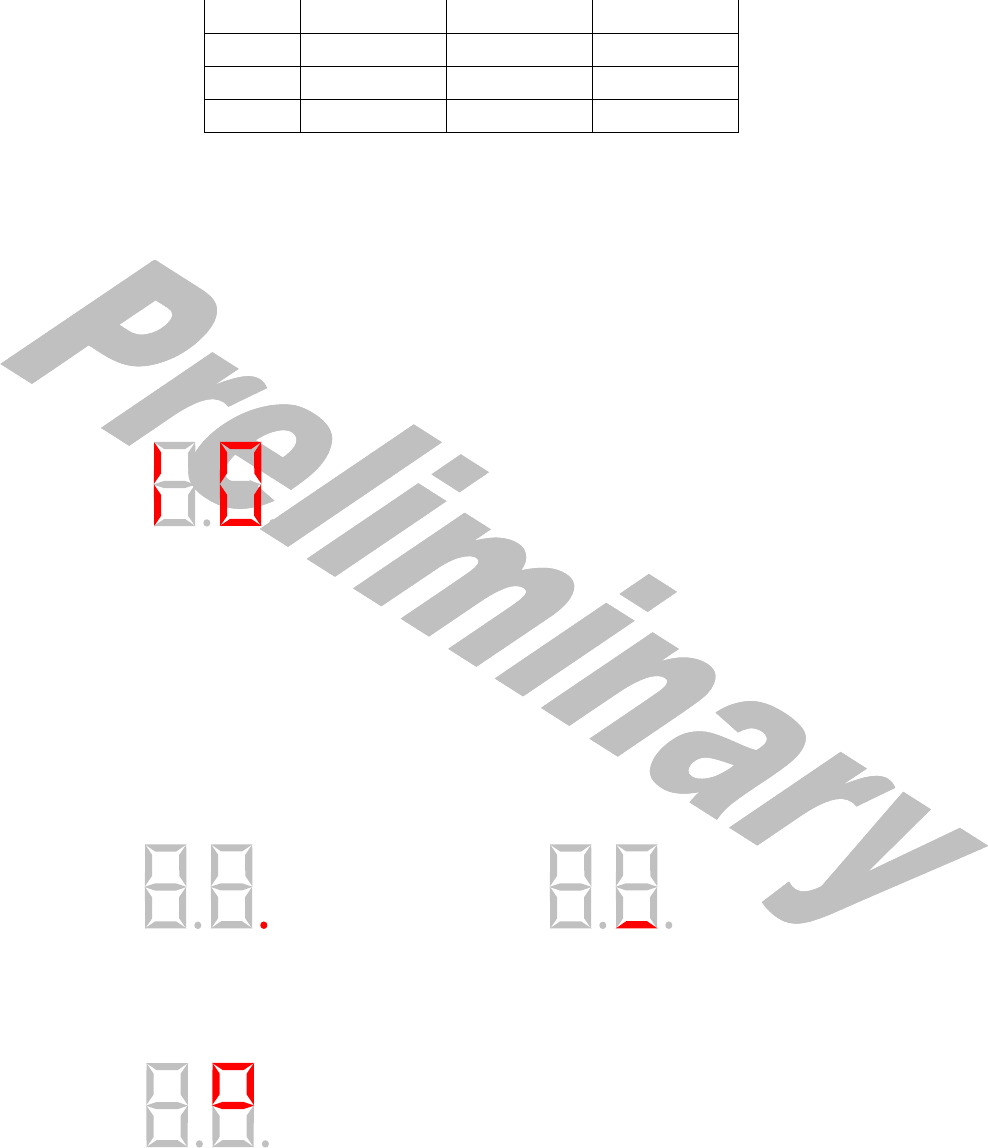Promark 9E3UB16 Bodypack Transmitter User Manual UB 16 Mnl wbk
Nady Systems Inc Bodypack Transmitter UB 16 Mnl wbk
Promark >
users manual

Preliminary 01/02
UB-16
UHF Wireless Microphone and Instrument System
16 Channel PLL Frequency Synthesized
OWNER’S MANUAL
TABLE OF CONTENTS:
FCC Warning Statement
A. INTRODUCTION
Using this Manual
B. SYSTEM FEATURES
UB-16
C. OPERATING INSTRUCTIONS
UB-16 Bodypack Transmitter
1. Powering the Transmitter
2. Selecting Input for Operation
3. Connecting the Audio Source
4. Turning on the Transmitter
5. Selecting the Operating Frequency
6. Selecting the Tone Squelch™ Mode
7. Locking the Keyboard
8. Microphone and Instrument Operation
a. Instrument Use
b. Microphone Use
D. FREQUENCY GUIDE
E. CHANNEL DISPLAY AND UP/DOWN BUTTONS OPERATION
1. UB-16 Transmitters
a. Changing the Channel Assignment
b. Selecting Tone Squelch™ Mode
c. Selecting Keyboard Lock
F. SPECIFICATIONS
UB-16 Transmitters
G. SERVICE FOR YOUR NADY WIRELESS SYSTEM
U.S.
International
FCC RF Exposure Statement
This device complies with FCC radiation exposure limits as set forth for an uncontrolled
environment. This device should be installed and operated so that its antenna(s) are not
co-located or operating in conjunction with any other antenna or transmitter.

Preliminary 01/02
A. INTRODUCTION
Thank you for choosing the Nady UHF 16 wireless system, and congratulations on your
choice. The Nady UHF 16 systems are by far the best performance and price value
available in professional UHF wireless.
Offering clear channel operation on the wide open, uncluttered UHF band for
interference-free performance in any application or locale, the UHF 16 delivers 16 user
switchable, frequency synthesized channels in pre-programmed groups in the 726 - 865
MHz range.
The UHF 16 systems feature Nady's proprietary companding and low noise circuitry for
an industry best 120 dB Dynamic Range, and the clearest, most natural sound available in
wireless today.
Using this Manual
This booklet gives instructions for the operation of the UHF 16 systems, including the
UB-16 Bodypack Transmitter, and the UH-16 Handheld Microphone Transmitter. Please
read this instruction booklet completely before operating your system, and refer to the
Nady UHF 16 Frequency Guide for the frequency band(s) and channels utilized by your
system.
This manual will first explain the benefits of the UHF 16 and then will take you step by
step on how to operate your new system. Each section will give you detailed information.
Also, included in this manual is the frequency selection chart, complete system
specifications, and servicing information.
B. SYSTEM FEATURES
UB-16 Transmitters
Choice of transmitters: UH-16 handheld or UB-16 bodypack, both 16-channel selectable
• UB-16 operates on 2 AA batteries for the longest reliable and economical battery
life.
• UB-16 bodypack is a versatile unit with unique 3-way input switch allowing it
operation selectively as an instrument, lavalier mic, or headworn mic transmitter
(with convenient DC phantom powering in the mic settings for condensers). An
input level control allows optimal audio gain adjustment, and a locking 3.5 mm
jack provides secure connection to the instrument cable, lavalier or headworn mic
cord.
• UB-16 transmitters features OFF/STANDBY/On controls, low battery LED
indicators, and offer easy channel selection via UP/DOWN buttons and a 2-
segment LED Channel display. C. OPERATING INSTRUCTIONS
UB-16 Bodypack Transmitter
1. Powering the Transmitter
Slide open the BATTERY COMPARTMENT (19) and insert 2 fresh AA ALKALINE
BATTERIES (20), observing the correct polarity.
AA
AA

Preliminary 01/02
Two fresh alkaline batteries can last up to 12 hours in use, but in order to ensure optimum
performance, it is recommended that the battery be replaced after 8-10 hours of use.
2. Selecting Input for Operation
The UB-16 is equipped with an INPUT SELECTOR SWITCH (21) in the battery
compartment for selecting the type of audio input you will be supplying to the
transmitter. Select from the choice of three positions: GT (for guitar, bass, etc.) / HM
(for headworn mic)/ LT (for lavalier mic).
3. Connecting the Audio Source
The UB-16 is provided with a 3.5 mm LOCKING JACK (22) for connecting the audio
input selected. Connect either the INSTRUMENT CORD (23) or the HEADWORN
MIC (24) or LAVALIER MIC CORD (25) as desired, according to the input selected.
(Note: Use only the input audio source as per the input selected with the AUDIO INPUT
SELECTOR SWITCH or the audio will not be optimal– a muddy or distorted sound may
result.) To secure the connection, turn the slip ring on the plug clock wise to thread it on
the jack. To unplug, reverse the process. Slip the transmitter into a pocket or CLIP (26) it
on to your clothes or instrument strap (if using the UB-16 as an instrument transmitter).
4. Turning on the Transmitter
Turn on the UB-16 by sliding the OFF/STANDBY/ON SWITCH (26) to the
STANDBY position (transmitter on, audio muted) or the ON position (transmitter and
audio both on). The BATTERY INDICATOR LED (27) will give a single quick flash,
indicating usable battery strength. In the case of dead or low batteries, the LED either
will not go on at all or will stay on continuously, indicating that the batteries should be
replaced with fresh ones. To preserve battery life; turn the transmitter off when not in
use. Inside the cover, the channel number on the CHANNEL LED DISPLAY (29) will
extinguish in 10 seconds. The activity indicator “ “ or “ “ LED will remain on.
5. Selecting the Operating Frequency
In order for the system to operate properly the same channel (frequency of operation)
must be selected for the UB-16 transmitter as was chosen for the UHF-16 receiver. Press
either the UP or DOWN CHANNEL SELECT BUTTON (28) until the channel number
indicated on the 2-segment CHANNEL LED DISPLAY (29) matches that of the UHF-
16 receiver.
6. Selecting the Tone Squelch™ Mode
Hold both the UP and DOWN BUTTONS (28) at the same time for 1 second. The Tone
Squelch™ will cycle from On to Off. See the CHANNEL DISPLAY AND UP/DOWN
BUTTON OPERATION section below.
7. Locking the Keyboard
To avoid accidental reconfiguration of the Channel setting or Tone Squelch™, the
keyboard can be locked buy holding both UP and DOWN BUTTONS (28) at the same
time for 3 seconds. See the CHANNEL DISPLAY AND UP/DOWN BUTTON
OPERATION section.

Preliminary 01/02
8. Microphone and Instrument Operation
The transmitter is now ready to use. The RECEIVED RF LEVEL ICON (11a), and
either the A or B DIVERSITY ICON (11b) on the UHF-16 receiver should now be lit,
indicating a received signal from the transmitter. The receiver MUTE LED
INDICATOR (X) should be off.
a. Instrument Use. Plug the 1/4" phone plug from the INSTRUMENT CORD (23)
into the instrument. Verify that the INPUT SELECTOR SWITCH (21) is in the GT
position. When ready to play, slide the audio OFF/STANDBY/ON SWITCH (26) to the
ON position. Adjust the volume of the receiver as per the Audio Output Instrument
Connections section of the above UHF-16 receiver instructions.
(Note: The INPUT LEVEL CONTROL (30) is deactivated and not used when the UB-16
is in GT, instrument mode. Levels should be adjusted with the volume control of your
instrument.)
(Note: Scratchy noises can sometimes occur when some electric guitars with dirty pots or
connections are used with any wireless system. Therefore, the supplied INSTRUMENT
CORD (23) has a factory installed capacitor inside the 1/4" plug. This capacitor
provides first order filtering of the RF signal from the cord into the guitar and eliminates
virtually all scratchy noises. Should your equipment still give you scratchy noises, we
suggest these steps to eliminate them:
1) Make sure all guitar volume and tone pots are clean and all contacts are solid–
this is very important.
2) A 47pf capacitor soldered across the hot to ground terminals of the guitar's
volume and tone pots will provide extra filtering.)
b. Microphone Use (with either a lavalier or headworn microphone)
Secure the connection from the LAVALIER (25) or HEADWORN MIC CORD (24)
by turning the slip ring on the plug into the transmitter clockwise to thread it on to the
jack. To unplug, reverse the process. To use the lavalier mic, attach it at chest level. Do
not place it too close to the mouth–a distance of about six inches usually works best. To
use the headworn mic, place it on the head and adjust the boom so that the mic is about
one inch to the side of the front of the mouth.
When ready to speak, verify that the INPUT SELECTOR SWITCH (21) is in either the
HM position (for a connected headworn mic, or the LT position for a lavalier mic and
slide the OFF/STANDBY/ON SWITCH (26) to the ON position. Adjust the volume of
the receiver as per the Audio Output Microphone For optimum performance, an
INPUT LEVEL CONTROL (30) is provided. Adjust the gain by turning the control
with the supplied small slotted screwdriver. For lavalier mic use, it is recommended that
the level be set at about 2/3 maximum. For headworn mic use, it may be advisable to turn
the gain down somewhat, depending on the volume levels expected. In either application,
experiment and set for maximum possible gain without audible distortion on the high

Preliminary 01/02
level peaks. (Note: Turning down the gain too much can compromise the signal-to-noise
and is not recommended.)
Cautions
1. Feedback
Observe care in selecting P.A. volume, transmitter location and speaker placement so that
acoustic feedback, howling and screeching, will be avoided. Please also note the pickup
pattern characteristics of the microphone selected. Omnidirectional mics pick up sound
equally from all directions, and are prone to feedback if not used carefully. Unidirectional
mics are more resistant to feedback, but pick up sound sources best that are directly in
front of the mic. Also, mics that are farther from the sound source, such as lavaliers,
require more acoustic gain and thus are also more prone to feedback than close-source
mics such as handheld or headworn models that are used close to the mouth.
2. Microphone Damage
Note: headset and lavalier mic users. Microphone element can easily be destroyed by the
buildup of salts and minerals from perspiration and saliva. It is good practice to put a
windscreen on the mic element at all times to protect it.)
3. No Audio
If the receiver is configured for Tone Squelch™ mute the transmitter must also be
configured to send the tones, otherwise the receiver audio will remain muted.
D. FREQUENCY GUIDE
The UHF 16 system is available with a choice of three frequency bands, each with 16
user-selectable frequencies. Select the band and frequencies appropriate to the
area/country in which the system is to be used.
U.S. U.S./Europe Europe
Channel Band 1 Band 2 Band 3
1 726.00 MHz 793.40 MHz 846.20 MHz
2 726.40 MHz 794.00 MHz 846.60 MHz
3 726.90 MHz 796.60 MHz 847.10 MHz
4 728.20 MHz 799.50 MHz 847.80 MHz
5 729.40 MHz 801.10 MHz 848.80 MHz
6 730.60 MHz 802.80 MHz 849.50 MHz
7 732.50 MHz 804.90 MHz 850.90 MHz
8 734.50 MHz 805.85 MHz 851.85 MHz
9 735.90 MHz 807.45 MHz 853.45 MHz
10 736.60 MHz 808.85 MHz 854.85 MHz
11 737.40 MHz 810.05 MHz 856.05 MHz
12 739.70 MHz 812.55 MHz 858.55 MHz

Preliminary 01/02
13 741.40 MHz 813.35 MHz 859.35 MHz
14 742.50 MHz 816.05 MHz 861.35 MHz
15 744.10 MHz 817.60 MHz 862.05 MHz
16 745.90 MHz 819.05 MHz 863.60 MHz
E. CHANNEL DISPLAY AND UP/DOWN BUTTON OPERATION
1. UB-16 Transmitters
Operation of Channel Display and Up and Down buttons, Keyboard Lock, and Tone
Squelch™
a. Changing the Channel Assignment
Press Up or Down button to change channels.
The Channel number indicator will vanish after 10 seconds. The Tone Squelch™
indicator and Keyboard Lock indicator will show the transmitter is On.
b. Selecting Tone Squelch™ Mode
Hold both Up and Down buttons at the same time for 1 second. Tone Squelch™ will
cycle from On to Off.
If the receiver Tone Squelch™ is enabled, it must also be enabled on the transmitter
otherwise the audio will remain muted.
c. Selecting Keyboard Lock
Hold both Up and Down buttons at the same time for 3 seconds. Keyboard lock will
cycle from Locked to Unlocked.
Channel #
Keyboard Locked
Tone Squelch™
Tones On
Tone Squelch™
Tones Off